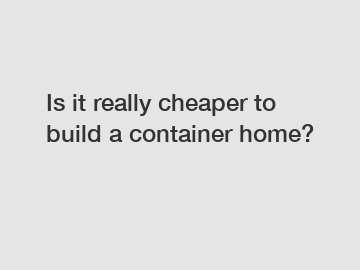Is it really cheaper to build a container home?
Goto TYGB to know more.
The idea of living in a unique and cost-effective container home has gained significant popularity in recent years. With its eco-friendly appeal and potential cost savings, many individuals are turning to this alternative housing option. But is it really cheaper to build a container home? In this blog, we delve into the realities and explore the various factors that can impact the overall cost-effectiveness of container homes.
1. Container Property Basics:

A container home is constructed using shipping containers typically made from steel, offering stability and durability. Proponents of this concept often argue that building with containers is more cost-effective than traditional construction methods. While this can be true in some instances, it is crucial to consider several factors before jumping into this alternative living solution.
2. Repurposing and Customization:
One of the main attractions of container homes is the ability to repurpose used shipping containers, reducing both material costs and environmental impact. However, it's important to note that customization and modification can significantly drive up the overall expenses. Cutting windows, doors, and incorporating insulation can add to the initial cost, requiring professional expertise and labor.
3. Foundation and Land Preparation:
Container homes, like any other residential property, require a solid foundation to ensure stability and long-term safety. Some individuals choose to opt for a pier or slab foundation, which can be more cost-effective. However, if you live in an area with challenging soil conditions or seismic activity, additional engineering and foundation reinforcement might be necessary. This can contribute to higher upfront costs.
4. Plumbing, Electrical, and HVAC Systems:
Integration of essential amenities such as plumbing, electrical, and HVAC systems is another area that can substantially impact the cost of building a container home. Adapting the container's structure to accommodate these installations may require expert assistance, increasing both labor and material costs. Engaging professionals is important to ensure code compliance and safety.
5. Local Regulations and Permits:
Before embarking on a container home project, it is critical to familiarize yourself with local regulations, zoning laws, and building permits. Some areas may have restrictions on container homes, requiring additional engineering reports, permits, and inspections. These added expenses can escalate your overall building cost, making it necessary to consult with local authorities and professionals.
6. Transport and Delivery:
Transportation costs are often overlooked but can be significant, particularly if you are sourcing containers from distant locations. Container delivery prices may vary depending on the distance, accessibility, and the fees associated with unloading and positioning the containers on your property. Obtaining accurate quotes from reputable transportation services helps in estimating your budget more accurately.
7. Interior Design and Finishes:
While container homes embrace a minimalistic aesthetic, interior finishes and design choices can considerably impact the costs. Flooring, cabinetry, fixtures, and other finishes need to be factored into your budget. Customization and personalization choices may add up, so it's essential to plan your designs carefully to remain within your desired budget.
8. Long-Term Costs and Maintenance:
While container homes are known for their durability, it's important to consider long-term costs associated with their maintenance. Proper insulation, ventilation, and regular maintenance are essential to ensure a comfortable living environment. Failing to address these aspects may result in increased energy costs and repairs down the line.
Conclusion:
Building a container home can provide an affordable and environmentally-friendly housing option for those seeking an unconventional living experience. However, it is important to be aware of the numerous factors that impact the overall cost. Repurposing containers may involve hidden costs associated with customization, foundation work, transportation, permits, and ongoing maintenance. Engaging professionals and thoroughly researching local regulations are vital steps to ensure a successful and cost-effective container home construction project. Ultimately, careful planning and budgeting will determine whether building a container home truly offers a cheaper alternative to traditional housing methods.
For more 20ft container homeinformation, please contact us. We will provide professional answers.



